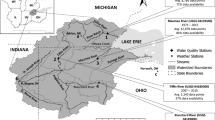Updated guidance is provided for presenting and interpreting individual Sediment Quality Triad components (Triad: chemistry, toxicity and community structure), and for the integration of all components. Three separate methods are identified: summary indices, tabular decision matrices, and multivariate analyses. Indices, an early method, are of limited usefulness. General guidance regarding decision matrices and multivariate analyses (in particular, statistical criteria for the combined Triad components) is provided, in a manner intended not to exclude future new techniques or approaches.
Similar content being viewed by others
References
Alden, R.W.II. (1992) Uncertainty and sediment quality assessments: I Confidence limits for the Triad. Environ. Toxicol. Chem. 11, 637–44.
Canfield, T.J., Dwyer, F.J., Fairchild, J.F., Haverland, P.S., Ingersoll, C.G., Kemble, N.E., Mount, D.R., LaPoint, T.W., Burton, G.A. and Swift, M.C. (in press) Assessing contamination in Great Lakes sediments using benthic invertebrate communities and the sediment quality triad approach. J. Great Lakes Res.
Canfield, T.J., Kemble, N.E., Grumbaugh, W.G., Dwyer, F.J., Ingersoll, C.G. and Fairchild, J.F. (1994) Use of benthic invertebrate community structure and the sediment quality triad to evaluate metalcontaminated sediment in the Upper Clark Fork River, Montana. Environ. Toxicol. Chem. 13, 1999–2012.
Carr, R.S. (1993) Sediment quality assessment survey of the Galveston Bay system. Galveston Bay National Estuary Program, GBNEP-30, Galveston, TX, 101pp.
Carr, R.S., Chapman, D.C., Howard, C.L. and Biebenbach, J.M. (in press) Sediment quality triad assessment of the Galveston Bay, Texas system. Ecotoxicology.
Chapman, P.M. (1990) The sediment quality triad approach to determining pollution-induced degradation. Sci. Total Environ. 97/98, 815–25.
Chapman, P.M. (1992a) Sediment quality triad approach. In Sediment Classification Methods Compendium. U.S. Environmental Protection Agency, Washington, D.C., EPA-823-R-92–006, pp. 10–1–10–18.
Chapman, P.M. (1992b) Pollution status of North Sea sediments — an international integrative study. Mar. Ecol. Prog. Ser. 91, 253–64.
Chapman, P.M. (1995) Extrapolating laboratory toxicity results to the field. Environ. Toxicol. Chem. 14, 927–30.
Chapman, P.M., Dexter, R.N., and Long, E.R. (1987) Synoptic measures of sediment contamination, toxicity and infaunal community structure (the Sediment Quality Triad). Mar. Ecol. Prog. Ser. 37, 75–96.
Chapman, P.M., Power, E.A., Dexter, R.N. and Andersen, H.B. (1991a) Evaluation of effects associated with an oil platform, using the sediment quality triad. Environ. Toxicol. Chem. 10, 407–24.
Chapman, P.M., Power, E.A. and Burton, G.A.Jr. (1991b) Integrative assessments in aquatic ecosystems. In G.A. BurtonJr. (ed) Contaminated Sediment Toxicity Assessment. pp. 313–340, Lewis Publishers, Chelsea, MI, USA.
Chapman, P.M., Paine, M.D., Arthur, A.D. and Taylor, L.A. (1996) A triad study of sediment quality associated with a major, relatively untreated marine sewage discharge. Mar. Pollut. Bull. 32, 47–64.
Conover, R. (1982) Practical Nonparametric Statistics, Second Edition. John Wiley & Sons: New York, NY, USA.
DiToro, D.M., Mahony, J.D., Hansen, D.J., Scott, K.J., Hicks, M.B., Mayer, S.M. and Redmond, M.S. (1990) Toxicity of cadmium in sediments: the role of acid volatile sulphide. Environ. Toxicol. Chem. 9, 1487–502.
Engle, V.D., Summers, J.K. and Gaston, G.R. (1994) A benthic index of environmental condition of Gulf of Mexico estuaries. Estuaries 17, 372–84.
EPA/ACOE. (1995) Evaluation of dredged material proposed for discharge in waters of the U.S. Testing Manual. U.S. Environmental Protection Agency and U.S. Army Corps of Engineers. EPA-823-B-94-002.
Green, R.H. (1993) Relating two sets of variables in environmental studies. In G.P. Patil and C.R. Rao (eds) Multivariate Environmental Statistics. pp. 140–63, Elsevier Science Publishers, New York, NY, USA.
Green, R.H., Boyd, J.M. and Macdonald, J.S. (1993) Relating sets of variables in environmental studies: the sediment quality triad as a paradigm. Environmetrics 4, 439–57.
Green, R.H., Montagna, P. and Kennicutt, M.C. II. (1995) Study designs for deciphering confounded environmental variables in impact assessments. Presented at the Second SETAC World Congress, November 1995, Vancouver, B.C.
Jackson, D.A. and Somers, K.M. (1989) Are probability estimates from the permutation model of Mandel's test stable? Can. J. Zool. 67, 766–9.
Kennicutt, M.C.II, (ed) (1995) Gulf of Mexico offshore operations monitoring experiment. Phase I: sublethal responses to contaminant exposure. OCS Study MMA 95–0000. Minerals Management Service, U.S. Dept. of Interior, New Orleans, LA.
Landis, W.G., Matthews, G.B., Matthews, R.A. and Sergeant, A. (1994) Application of multivariate techniques to endpoint determination, selection and evaluation in ecological risk assessment. Environ. Toxicol. Chem. 13, 1917–28.
Legendre, P. and Fortin, M-J. (1989) Spatial patterns and ecological analysis. Vegetation 80, 107–38.
Long, E.R. (1989) The use of the Sediment Quality Triad in classification of sediment contamination. In Marine Board, National Research Council Symposium/Workshop on Contaminated Marine Sediments. NRC, Washington, D.C., USA.
Long, E.R. and Chapman, P.M. (1985) A sediment quality triad: measures of sediment contamination, toxicity and infaunal community composition in Puget Sound. Mar. Pollut. Bull. 16, 405–15.
Mantel, N. (1967) The detection of disease clustering and a generalized regression approach. Cancer Res. 27, 200–9.
Nemec, A.F.L. and Brinkhurst, R.O. (1988a) Using the bootstrap to assess statistical significance in the cluster analysis of species abundance data. Can. J. Fish. Aquat. Sci. 45, 965–70.
Nemec, A.F.L. and Brinkhurst, R.O. (1988b) The Fowles-Mallows statistic and comparison of two independently determined dendrograms. Can. J. Fish. Aquat. Sci. 45, 971–5.
Paine, M.D., Chapman, P.M., Allard, P.J. and Murdoch, M.H. (in press) The sediment quality triad approach indicates limited bioavailability of PAH from an aluminum smelter. Environ. Toxicol. Chem.
Reynoldson, T.B., Day, K.E. and Norris, R.H. (1995) Biological guidelines for freshwater sediment based on BEnthic Assessment of SedimenT (BEAST) using a multivariate approach for predicting biological state. Aust. J. Ecol. 20 (in press).
Sehlekat, C.E., McGee, B.L., Boward, D.M., Reinharz, E., Velinsky, D.J. and Wade, T.L. (1994) Tidal river sediments in the Washington, D.C. area. II. Biological effects associated with sediment contamination. Estuaries 17, 334–44.
Suter, G.W.II. (1993) Ecological Risk Assessment. Lewis Publishers: Boca Raton, FL, USA.
Suter, G.W. II.(in press) Overview of the ecological risk assessment framework. In SETAC (Society of Environmental Chemistry and Toxicology) Sediment Ecological Risk Assessment Workshop.
Zar, J.H. (1984) Biostatistical Analysis. Second Edition. Prentice-Hall: Englewood Cliffs, NJ, USA.
Author information
Authors and Affiliations
Rights and permissions
About this article
Cite this article
Chapman, P.M. Presentation and interpretation of Sediment Quality Triad data. Ecotoxicology 5, 327–339 (1996). https://doi.org/10.1007/BF00119054
Received:
Accepted:
Issue Date:
DOI: https://doi.org/10.1007/BF00119054




